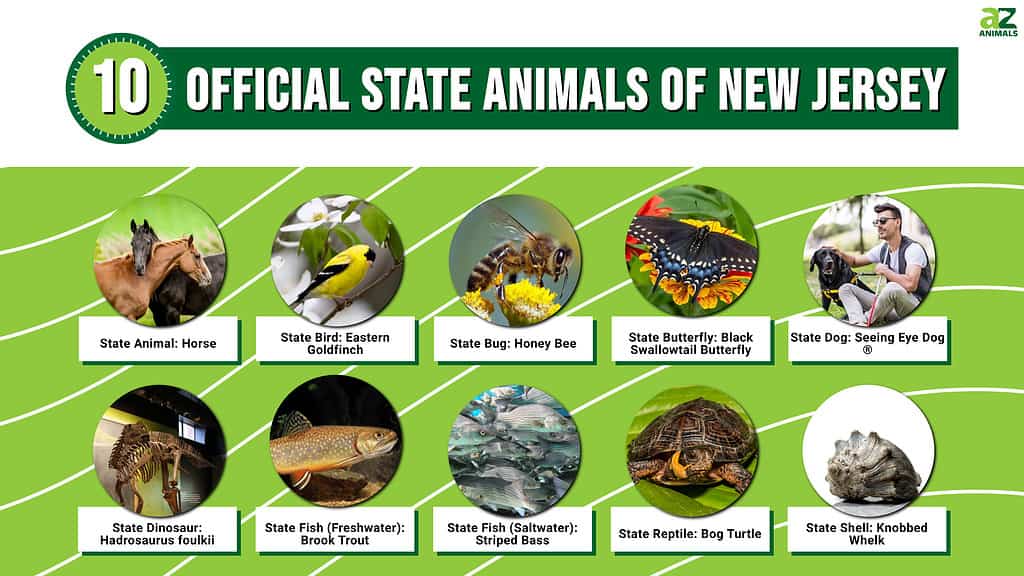
Every state in the United States has official state symbols, including animals that represent the state’s unique geography, culture, history, and economy. New Jersey lawmakers have chosen ten animals to represent their state. Here is a list of those ten animals, along with how and why they were chosen as representatives of The Garden State.
1. State Animal: Horse
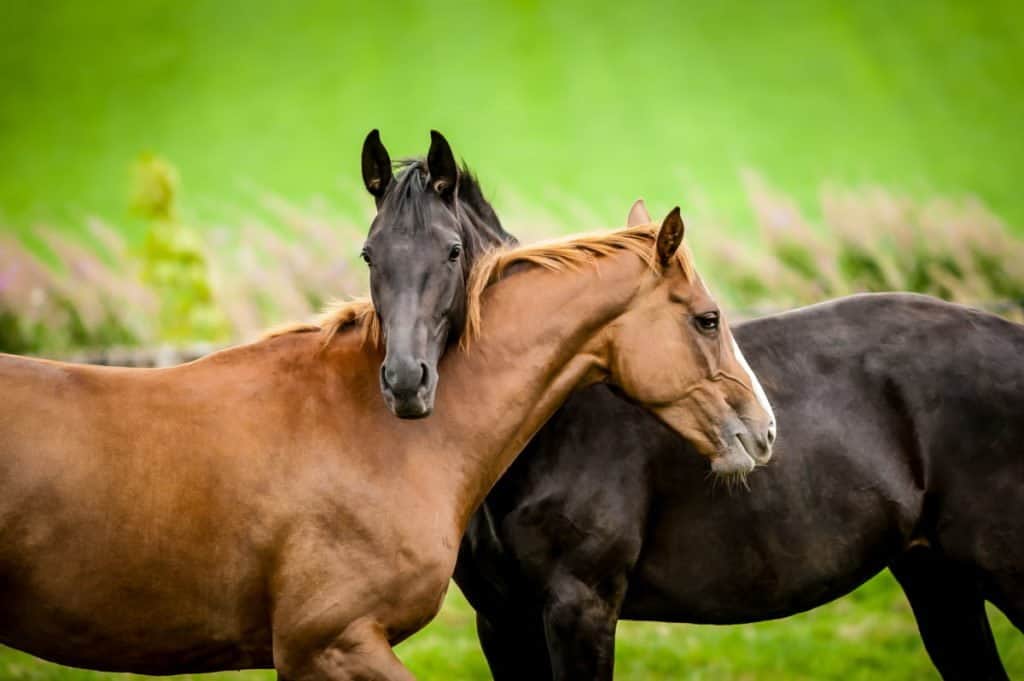
New Jersey’s historical and current-day horse culture led to an easy choice for the state’s official animal.
©cornfield/Shutterstock.com
New Jersey’s state animal was made official in 1977 through the efforts of a fifth-grader and an eighth-grader. The students championed the horse (Equus caballus) as the best choice for New Jersey’s state animal. Their efforts were rewarded when lawmakers passed the bill, and Governor Brendan Byrne (D) signed it into law.
At the signing, Governor Byrne remarked, “The founding fathers of our state thought so highly of the horse that they included it in our state seal. Today there are 4,654 horse farms in New Jersey, of which 888 raise racing horses. The horse industry makes a contribution to the preservation of green acres at a time when great demands are being made for the preservation of our land.”
The governor’s thoughts from 1977 still reflect life in New Jersey today. The U.S. Equestrian Team Foundation is headquartered in New Jersey. There are still thousands of horse farms in the state. In addition, hundreds of thousands of acres within the state are dedicated to equestrian activities.

Dozens of horse tracks are found in New Jersey.
©gabriel12/Shutterstock.com
Horse racing is a huge economic and tourism driver for the state, with dozens of tracks. As the governor noted, the horse features prominently on the state seal. That seal appears on New Jersey’s state flag. The equine is so strongly linked with the history and culture of New Jersey that it would be difficult to come up with a more appropriate state animal.
2. State Bird: Eastern Goldfinch
The eastern goldfinch (Carduelis tristis) was named the New Jersey state bird in 1935. This finch is also the official avian symbol of Iowa and Washington.
Changing Colors
The eastern goldfinch, also known as the American goldfinch, has two very distinct looks based on the time of year. In the winter, the bird is a muted olive-gray color. But in the spring, the bird molts, and the olive-gray plumage is traded in for yellow and black. Both males and females go through this change, but the males feature a much brighter yellow hue than the females.
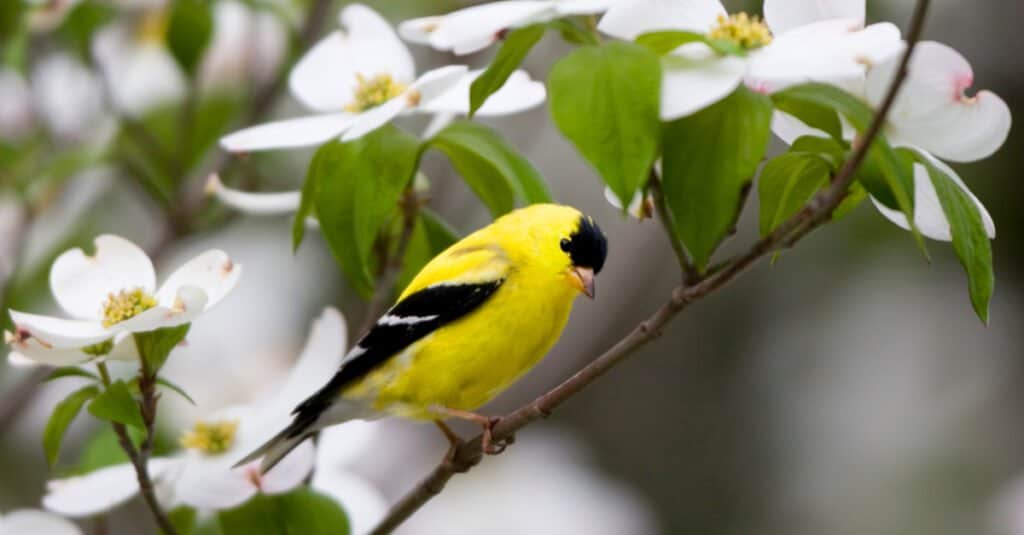
The male eastern goldfinch has brighter coloring in the summer to attract a mate.
©Danita Delimont/Shutterstock.com
This seasonal color change is mostly about mating. The males need to appear especially vibrant to strike a female’s interest. But when winter rolls around, the birds bid farewell to the beautiful, bright plumage and reassume the much more drab olive-gray feathers. While they aren’t as striking to our eyes in the winter, this dull coloration helps hide eastern goldfinches from more important sets of eyes: the eyes of predators, such as hawks. A bright yellow bird against a drab winter landscape would be far too easy for a predator to spot, so the color change is vital for the eastern goldfinch’s survival.
The eastern goldfinch is not a migratory bird but a nomadic feeder. New Jersey residents may or may not see them in the winter. It depends largely on food availability. These birds tend to disappear and then reappear throughout the winter season. A bird feeder stocked with sunflower seeds is a good way to keep these birds coming back to your yard.
The eastern goldfinch has a variety of vocalizations, including a song with a series of crisp warbles and twitters. It is a cheery songbird that is found throughout New Jersey.

The eastern goldfinch is a color-changing marvel!
©iStock.com/Ronald Washington
The Mystery of New Jersey’s State Bird
We don’t know why this bird was chosen as the official state bird of New Jersey in 1935. It probably had something to do with the bird’s beauty and its proliferation in the state. Still, the actual legislation (New Jersey Statute Title 52, Section 52:9A-1) does not state the reason behind the designation. No journalistic records from the period have been found to give insight into the reasons for the decision, either. New Jerseyans can certainly appreciate the loveliness of the eastern goldfinch, but they may never know exactly why it became their state bird.
3. State Bug: Honey Bee
New Jersey’s state insect (or bug, as it is called in the official state legislation) is the honey bee (Apis spp.). New Jersey joins 16 other states in giving the honey bee official status, making it the most common insect state symbol in the U.S. The designation in New Jersey came at the behest of a group of fifth-grade students from the Sunnybrae School in Hamilton Township. The children gave a presentation at the statehouse to advocate for the honey bee. Legislators followed their lead and passed the bill. Governor Byrne signed it on June 20, 1974.
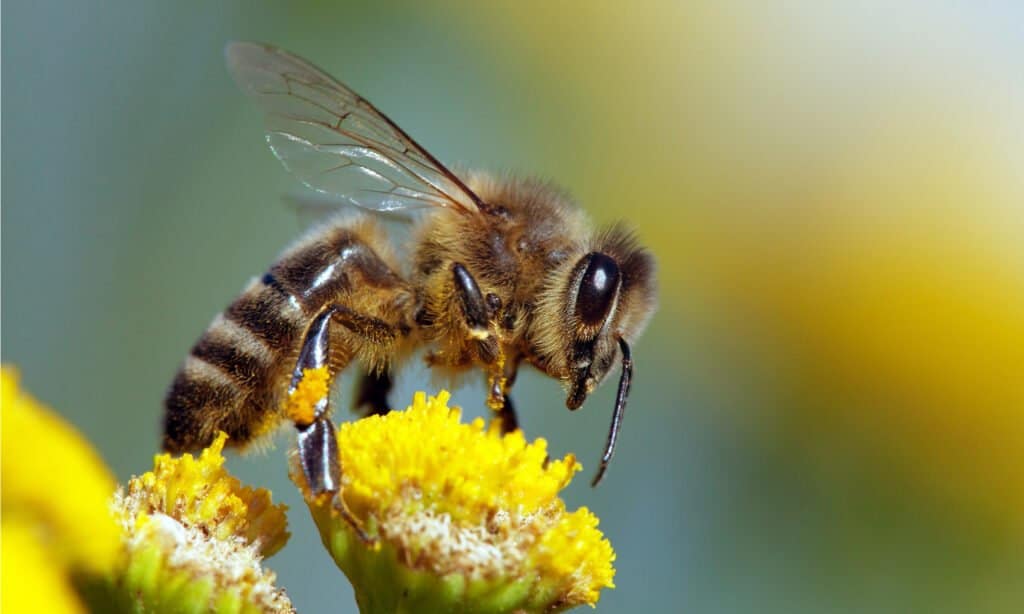
Honeybees are critically important pollinators.
©Daniel Prudek/Shutterstock.com
The honey bee is one of the most essential pollinators in North America. The bee pollinates over 150 food crops in the U.S. alone. Around one-third of the food Americans eat is pollinated by the honey bee.
In New Jersey, the honey bee is a vital pollinator for crops such as apples, blueberries, cantaloupes, cranberries, cucumbers, and watermelons.
A variety of introduced insect and bacterial parasites has plagued honey bees. As a result, it is rare to find natural colonies, so beekeeping is essential for agriculture and gardening. This is the primary reason so many states, including New Jersey, have given the honey bee official state status. It would be difficult to find an insect that humans rely on more than the honey bee.
4. State Butterfly: Black Swallowtail Butterfly
Along with the honey bee, New Jersey has a second official insect. The black swallowtail butterfly (Papilio polyxenes) is the state’s official butterfly.
The black swallowtail, also known as the Eastern black swallowtail or parsnip swallowtail, features dark black wings with colorful yellow/orange spots. Females also feature bright blue hues on their hindwings. The wingspan of this large butterfly can reach 3.5-3.75 inches.

The Black Swallowtail Butterfly features lovely black wings with hues of white, orange, and blue.
©Melody Mellinger/Shutterstock.com
A Chance Discovery Leads to State Legislation
Jeannie Geremia spearheaded the move to grant the black swallowtail official state status. She was a leader in The Garden Club of New Jersey and had a fascination with butterflies. Specifically, the black swallowtail butterfly caught her attention when she purchased an herb. She noticed two caterpillars munching on the plant. Thinking they might be monarch caterpillars, she placed them in a cage. Each formed a chrysalis, and eventually, two black swallowtails emerged. Geremia was enchanted by the insects but probably still had no idea how this fascination would grow into official state legislation.
Years later, Geremia found out that her state did not have an official butterfly. In her mind, the black swallowtail was the easy choice. The butterfly is found in all of New Jersey’s 21 counties. It spends its entire life in the state, whereas the more well-known monarch butterfly heads to Mexico in the winter.
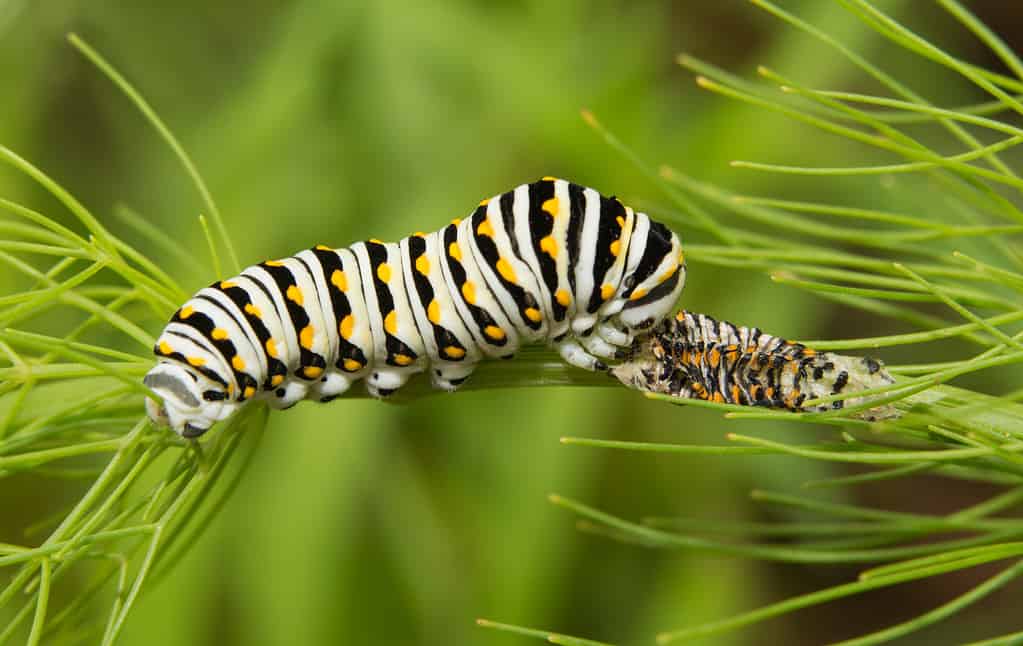
Jeannie Geremia’s discovery of two black swallowtail caterpillars eventually led to the adoption of New Jersey’s state butterfly.
©Sari ONeal/Shutterstock.com
It took a great deal of patience and persistence, but it eventually paid off. Legislators voted unanimously to pass the bill designating the black swallowtail as the state butterfly. Governor Chris Christie (R) signed the bill into law on January 11, 2016.
New Jersey joined Oklahoma as the only other state to honor the black swallowtail as its state butterfly.
5. State Dog: Seeing Eye Dog ®
The official state dog (Canis lupus familiaris) of New Jersey is the Seeing Eye Dog. Governor Phil Murphy (D) signed the legislation on January 21, 2020. This dog is a true New Jersey icon.
All Seeing Eye Dogs are born and trained in Morristown, New Jersey before they are placed with visually-impaired people across the United States and Canada. While used colloquially to describe many guide dogs, “Seeing Eye” is actually a registered trademark of The Seeing Eye, Inc. in Morristown.

Service dogs are invaluable to the lives and well-being of their owners.
©iStock.com/Halfpoint
In his remarks on New Jersey’s state dog designation, Seeing Eye President & CEO Glenn Hoagland said, “When our non-profit was founded, few people believed dogs could contribute to the health and wellness of humankind in the myriad of ways they do today. The work of our founders paved the way for acceptance of assistance animals in society, eventually leading to their incorporation into the Americans with Disabilities Act.”
Senator Anthony M. Bucco, whose father introduced the bill before his death, said the designation reflected his father’s “deeply held belief that everyone deserves the opportunity to live with dignity and respect.”
Assemblywoman Aura Dunn, who co-sponsored the bill, said, “These highly trained, intelligent, loyal, and gentle service dogs are indispensable. The guide dogs, and the individuals who train them, truly are a representation of everything good in New Jersey.”
While several states now have official state dogs, New Jersey’s state dog certainly belongs in a class all its own.
6. State Dinosaur: Hadrosaurus foulkii
New Jersey’s state dinosaur may have lived 70-100 million years ago, but it was given official status alongside the other nine state animals in 1991. During the Cretaceous period, an odd-looking duck-billed dinosaur roamed the swamps and forests along the ancient seacoasts of what would become New Jersey. This dinosaur would eventually become an official New Jersey symbol.
The first glimpse of this beast’s fossilized bones came in the 1830s when some workers found a number of huge bones in a New Jersey marl pit. Marl deposits, also known as greensand, were left in New Jersey by the ancient seawater that once covered the land. Colonial farmers discovered that marl is an excellent fertilizer. Marl pits were dug in New Jersey’s Inner Coastal Plan, and the greensand was sold to farmers in New Jersey and beyond. These marl pits became the namesake of some New Jersey towns, such as Marlton and Marlboro.
More Than Marl
After many years of marl excavation, the marl pits were found to contain more than fertilizer when those 19th-century workers discovered the fossilized bones. The find caused a minor stir, but nothing much came of it until 20 years later. That’s when William Parker Foulke was vacationing in Haddonfield. During his holiday, he heard about the discovery of those bones 20 years prior. A man of means, he hired a work crew to excavate the site. They worked shin-deep in gray slime through the late summer and early fall, but they eventually found what Foulke was seeking.
The fossils this crew unearthed belonged to a prehistoric dinosaur that came to be known as Hadrosaurus foulkii, named in honor of Haddonfield, New Jersey, where it was found, and also as a nod to William Parker Foulke, who led the discovery expedition. At the time of its 1858 discovery, the “Haddy” was the most complete dinosaur skeleton ever unearthed. Ten years later, it became the first mounted dinosaur skeleton in the world.
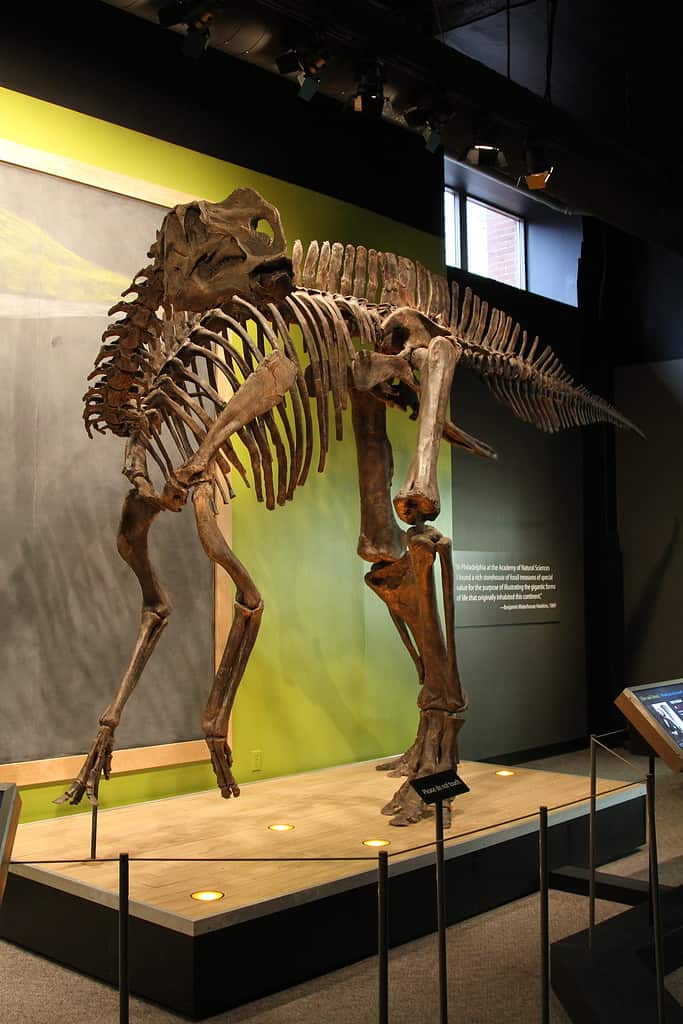
The
Hadrosaurus foulkiiwas the first dinosaur skeleton ever mounted.
©Jim, the Photographer from Springfield PA, United States of America / CC BY 2.0 – License
The Hadrosaurus foulkii was about 25 feet long and likely weighed 7-8 tons. It appears that it ran on its hind legs, but probably stood on all four legs while grazing. The blunt teeth point to the dinosaur’s herbivorous diet.
The designation of Hadrosaurus foulkii as the state dinosaur began with a teacher, Joyce Berry, and her fourth-grade classes at Strawbridge Elementary School in Haddon Township. They lobbied legislators to give the dinosaur its official status, and the state’s lawmakers obliged. The dinosaur received its state designation on June 13, 1991.
7. State Fish (Freshwater): Brook Trout
The brook trout (Salvelinus fontinalis) was named the state fish of New Jersey when Governor Jim Florio (D) signed Assembly Bill 2608 on January 8, 1992. New Jersey is certainly not alone in this designation, though. Along with New Jersey, various species of brook trout have been chosen as state symbols in Georgia, Michigan, New Hampshire, New York, North Carolina, Pennsylvania, Vermont, Virginia, and West Virginia. Brook trout can only survive in exceptionally clean, cold water, so the fish has come to symbolize the importance of conserving the natural waterways in all of these states, including New Jersey.
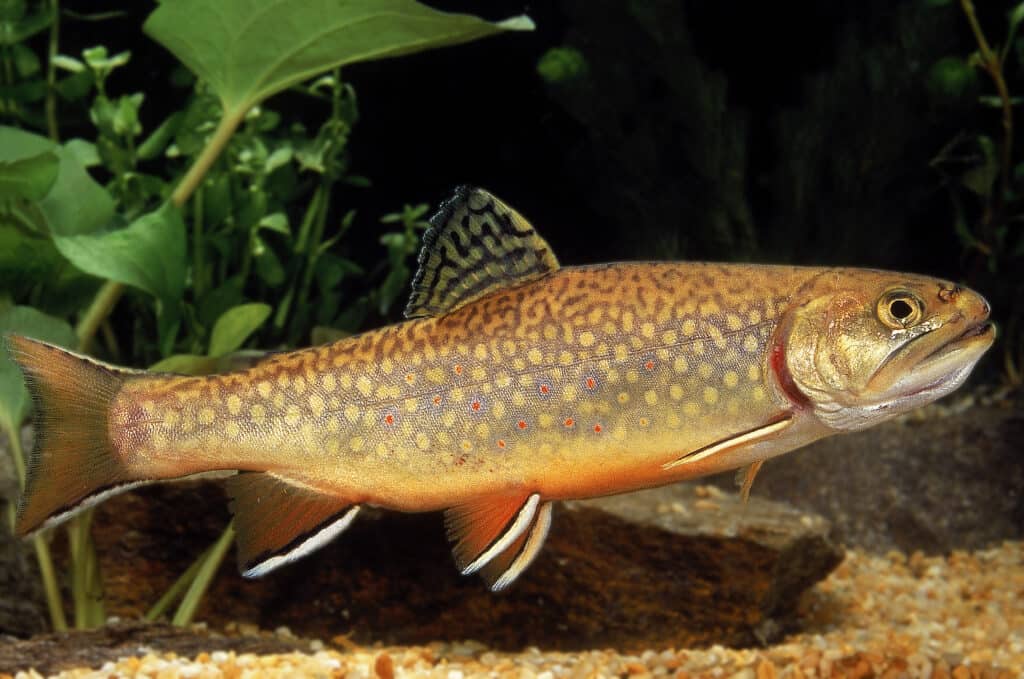
The Brook Trout can only survive in exceptionally clean, cold water.
©Slowmotion GLI/Shutterstock.com
Rescuing New Jersey’s Brook Trout
While other trout species are now found in the state, the brook trout is the only species native to New Jersey. Historically, brook trout occupied nearly 200 of the state’s 900 watersheds. Today, brook trout have been extirpated in many of these watersheds, resulting in a 62% loss of their native habitat. This is the largest loss recorded by any state within the brook trout’s native range.
Strict conservation measures have been implemented to help replenish the state’s brook trout population. No brook trout under nine inches long may be harvested anywhere in the state. Even more significantly, the Brook Trout Conservation Zone (BTCZ) was put in place in 2018. The BTCZ lies between two major roadways (Interstate 287 and Route 202), the Delaware River, and the New Jersey – New York state line. No brook trout, regardless of size, may be harvested in the BTCZ. Any brook trout that is caught must be immediately released unharmed.
Wild brook trout in New Jersey are typically nine inches or less in length (hatchery fish can be longer) and weigh 1-1.5 pounds. The state record brook trout weighed 7 pounds 3 ounces. Andrew DuJack caught that huge “brookie” while fishing in Rockaway River in 1995.
8. State Fish (Saltwater): Striped Bass
Like many other coastal states, New Jersey has both a state freshwater and state saltwater fish. The striped bass (Morone saxatilis) was adopted as the state’s official saltwater fish in 2017.
On the Atlantic Coast, the striped bass (or “striper”) ranges from Canada to Florida. This is evidenced by the number of Atlantic states that have named the striped bass as their state saltwater fish. Along with New Jersey, the striped bass has been given that official designation in New Hampshire, New York, Rhode Island, South Carolina, and Virginia.
Even though the fish is the official saltwater fish in these six states, the striped bass can actually survive in both saltwater and freshwater. This anadromous fish lives in the ocean, but it moves into estuaries and then into freshwater to spawn.
New Jersey has placed limits on the striped bass harvest in order to protect this valuable fish. Striper fishing season lasts from March 1 to December 31. Recreational anglers may keep one striper measuring 28-43 inches, and one additional fish measuring 43 inches or greater.
An average striper may measure around 30 inches and weigh 20-40 pounds. The state record striped bass weighed a whopping 51 pounds! John Christian caught that monster striper in Great Egg Harbor River in 2002. It is the largest fish caught on a rod and reel ever recorded in the state.

Striped bass is the official saltwater fish in six states along the U.S. Atlantic coast.
©Pelow Media/Shutterstock.com
9. State Reptile: Bog Turtle
The bog turtle (Glyptemys muhlenbergii) was designated the official State Reptile of New Jersey on June 18, 2018. Measuring only three to four inches long, it is the smallest turtle species in North America. However, its diminutive size isn’t the only reason this turtle can be hard to spot in New Jersey. It is also critically endangered. Habitat loss, pollution, and illegal collecting have all combined to decimate the bog turtle population. It was officially classified as endangered in 1997.
Also known as Muhlenberg’s turtle, the bog turtle is found exclusively in bogs and wetlands in the northeastern United States. In New Jersey, bog turtles were once found throughout the state. Today, the remaining concentrations of bog turtles are largely found in only four of the state’s 21 counties: Sussex, Warren, and Hunterdon counties in the north/northwest and Salem County in the southwestern part of the state.
The Bog Turtle Project was implemented in an effort to save this teeny reptile. The project involves saving the remaining bog turtle habitat from development, partnering with private landowners, and controlling the invasive European wetland plant, purple loosestrife, among many other measures.
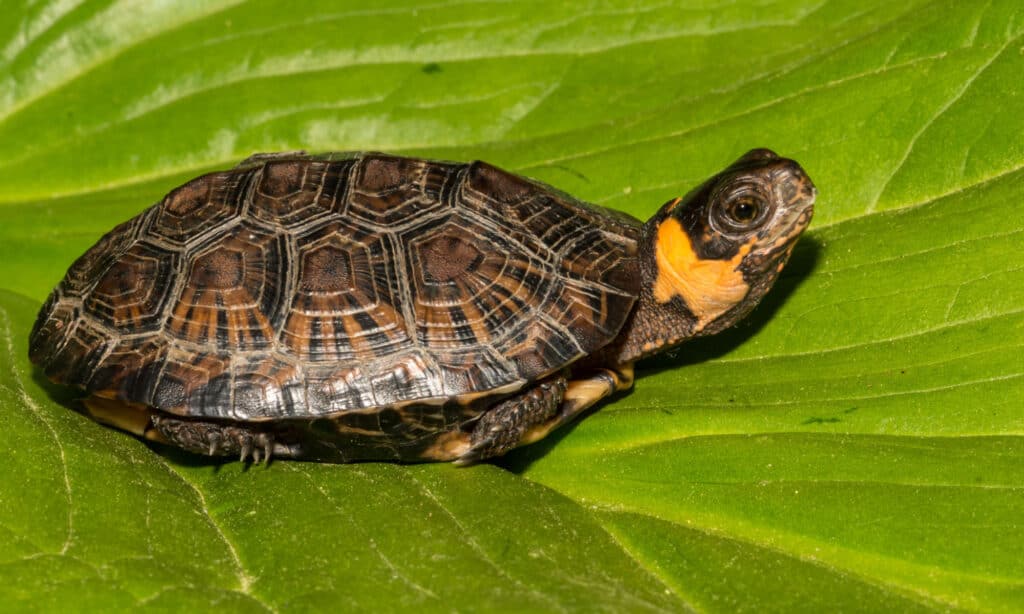
The tiny bog turtle is only three to four inches long.
©Jay Ondreicka/Shutterstock.com
10. State Shell: Knobbed Whelk
The knobbed whelk (Busycon carica gmelin) was named the official state shell of New Jersey in 1995. Though it is often known as a conch shell, true conchs are found in tropical waters. Whelks, such as the knobbed whelk, are found in more temperate waters.
While in New Jersey’s coastal waters, the shell is home to a sea snail. This large predatory marine snail’s native range is found along the U.S. Atlantic coast, from Massachusetts to Florida. The knobbed whelk is also the state shell of Georgia.
These sea snails prey on clams, oysters, and other marine bivalve mollusks. The snails are harvested for human use. They are popular ingredients in chowders and other seafood dishes.
The shells are spiral-shaped and feature a yellow-gray color. They can be found along all the beaches and bays in New Jersey.
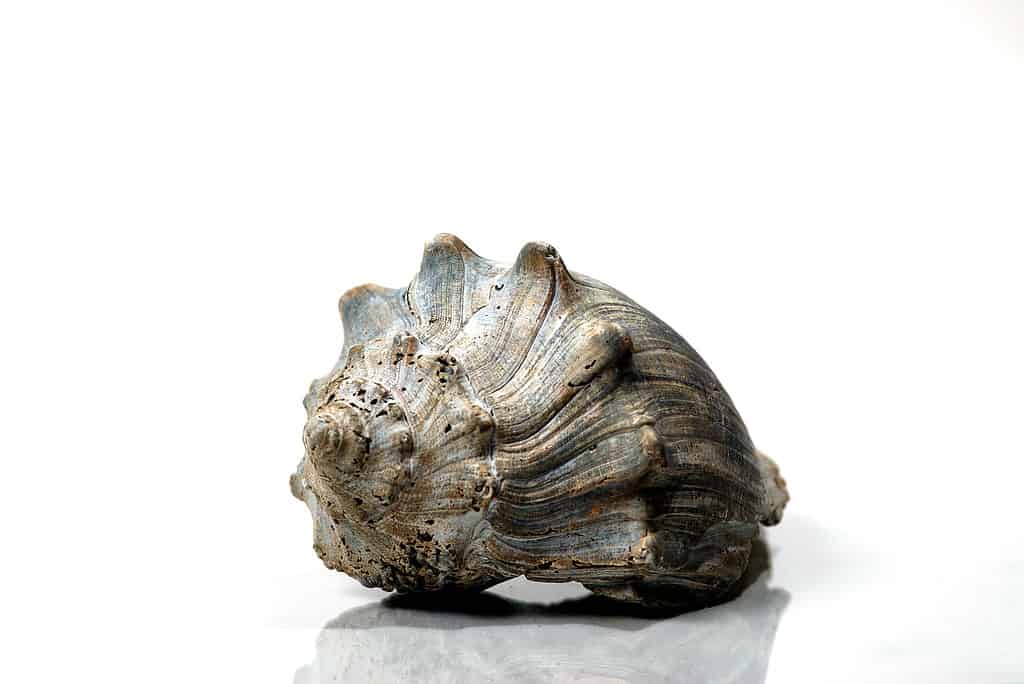
The knobbed whelk can be found along New Jersey’s entire coastline.
©iStock.com/ChristopherSZachary
Summary of the 10 Official State Animals of New Jersey
| Official Title | Animal | |
|---|---|---|
| 1 | State Animal | Horse |
| 2 | State Bird | Eastern Goldfinch |
| 3 | State Bug | Honey Bee |
| 4 | State Butterfly | Black Swallowtail |
| 5 | State Dog | Seeing Eye Dog ® |
| 6 | State Dinosaur | Hadrosaurus foulkii |
| 7 | State Fish (Freshwater) | Brook Trout |
| 8 | State Fish (Saltwater) | Striped Bass |
| 9 | State Reptile | Bog Turtle |
| 10 | State Shell | Knobbed Whelk |
The photo featured at the top of this post is © Cheryl Ann Quigley/Shutterstock.com
Thank you for reading! Have some feedback for us? Contact the AZ Animals editorial team.






